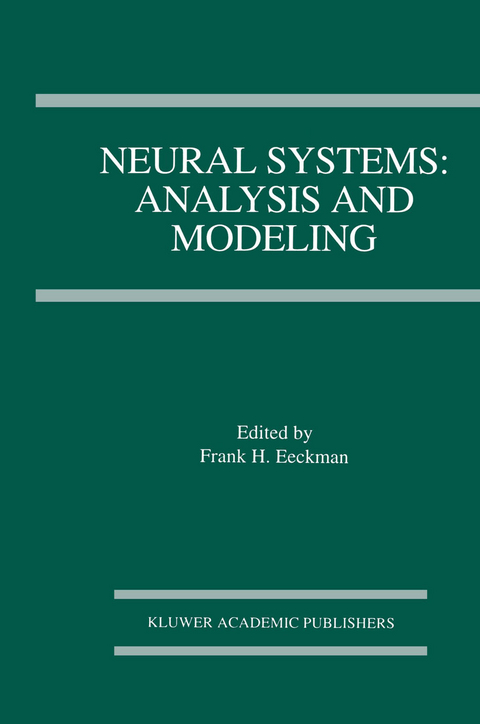
Neural Systems: Analysis and Modeling
Springer-Verlag New York Inc.
978-1-4613-6581-5 (ISBN)
Neural Systems: Analysis and Modeling contains the collected papers of the 1991 Conference on Analysis and Modeling of Neural Systems (AMNS), and the papers presented at the satellite symposium on compartmental modeling, held July 23-26, 1992, in San Francisco, California. The papers included, present an update of the most recent developments in quantitative analysis and modeling techniques for the study of neural systems.
I - Analysis and Modeling Tools and Techniques.- Section 1: Analysis.- Optimal Real-Time Signal Processing in the Nervous System.- Measuring the Coding Efficiency of Sensory Neurons.- Non-linear Analysis of Models for Biological Pattern Formation:Application to Ocular Dominance Stripes.- A Hierarchical Sensory-Motor Architecture of Oscillating Cortical Area Subnetworks.- A Computationally Efficient Spike Initiator Model that Produces a Wide Variety of Neural Responses.- Linearization by Noise and/or Additional Shunting Current of a Modified FitzHugh Nagumo Spiking Model.- Section 2: Modeling.- Genesis: A Neuronal Simulation System.- CAJAL-91: A Biological Neural Network Simulator.- Nodus: A User Friendly Neuron Simulator for Macintosh Computers.- NeMoSys: An Approach to Realistic Neural Simulation.- NEURON-A Program for Simulation of Nerve Equations.- II - Sensory Systems.- Section 3: Visual System.- Models of Activity-Dependent Neural Development.- Visual Inputs and Information Processing in Sensory Cortex: An in vivo Developmental Study.- Motion Detection and Directional Selectivity in the Crayfish Visual System.- Neither DoG nor LoG Fits the Receptive Field of the Vertebrate Cone.- Cellular and Network Determinants of Visual Motion Properties in Cortical Neurons: Studies with an in vitro Preparation of Visual Cortex.- Section 4: Auditory System.- Reconstruction of Target Images in the Sonar of Bats.- Non-phase Locked Auditory Cells and ‘Envelope’ Detection.- Model of the Origin of Neuronal Selectivity for Binaural Intensity Difference in the Barn Owl.- A Resonance Model of High Frequency Binaural Phase Sensitivity in the Barn Owl’s Auditory Brainstem.- A Computational Model of the Cat Medial Geniculate Body Ventral Division.- Simulation of Neural Responses thatUnderlie Speech Discrimination.- Section 5: Other Sensory Systems.- The Jamming Avoidance Response (JAR) of the Electric Fish, Eigenmannia: Computational Rules and Their Neuronal Implementation.- ‘Small Cell’ Simulations: Physiological Features of a Phase Difference Detector.- Compartmental Modeling of Macular Primary Neuron Branch Processes.- Modeling of Chaotic Dynamics in the Olfactory System and Application to Pattern Recognition.- III - Motor Systems.- Section 6: Central Pattern Generations (CPG’s).- Computational Implications of a Serotonin-Sensitive Region of Axonal Membrane on a Dual Function Motor Neuron.- Section 7: Cortex, Cerebellum and Spinal Cord.- Nonlinear Synaptic Integration in Neostriatal Spiny Neurons.- Modeling Vestibulo-Ocular Reflex Dynamics: From Classical Analysis to Neural Networks.- Movement Primitives in the Frog Spinal Cord.- Model and Simulation of a Simplified Cerebellar Neural Network for Classical Conditioning of the Rabbit Eye-blink Response.
| Zusatzinfo | IX, 465 p. |
|---|---|
| Verlagsort | New York, NY |
| Sprache | englisch |
| Maße | 155 x 235 mm |
| Themenwelt | Informatik ► Theorie / Studium ► Künstliche Intelligenz / Robotik |
| Naturwissenschaften ► Biologie ► Zoologie | |
| Naturwissenschaften ► Physik / Astronomie ► Angewandte Physik | |
| Naturwissenschaften ► Physik / Astronomie ► Thermodynamik | |
| Technik ► Elektrotechnik / Energietechnik | |
| ISBN-10 | 1-4613-6581-3 / 1461365813 |
| ISBN-13 | 978-1-4613-6581-5 / 9781461365815 |
| Zustand | Neuware |
| Haben Sie eine Frage zum Produkt? |
aus dem Bereich


